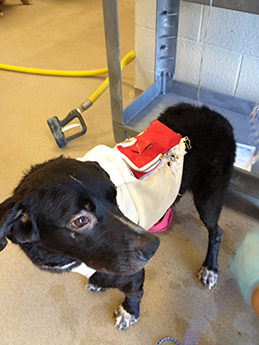The Dog Pheromone
Dr. McGlone visits with Cesar Milan about dog pheromones
Scientific Abstract
From ADSA-AMPA-ASAS-CSAS-WSASAS Joint Annual Meeting, July 8-12, 2013 in Indianapolis, Indiana
Pheromones and an Interomone Change the Physiology and Behavior of Anxious Dogs
W. G. Thompson* and J. J. McGlone
Texas Tech University, Lubbock.
Pheromones are species-specific odors used in communication and have been shown to have both behavioral and physiological effects. Interomones are pheromones in one species, but have diverse effects on other species. The objective of this study was to assess the efficacy of pheromones/interomones to modulate heart rate (HR) and behavior in adult anxious dogs (trembling, cowering, shy). The dogs (10.2±4.2 kg; estimated 5-10 yr old, intact males) and were professionally diagnosed as anxious. Each dog was housed in a separately-ventilated room with a minimum of 12 m² of floor space. Heart rate was measured using a telemetry system (Data Science International, St. Paul, MN USA). Behavior was recorded and later processed by a trained individual (blind to treatment group) using a scan sample with a recording interval of 5 min over a 24 h baseline period. At the end of 24 h with a treatment or control pheromone collar, each dog was startled with a 110 db fog horn while behavior and HR were recorded. Each dog received each treatment in a Latin Square design with repeated measures over time. This model allowed evaluation of effects of treatment, dog, treatment by dog, time, treatment by time and dog by time effects. Treatments were given in the form of a collar containing each pheromone/interomone and included Placebo, Sergeant's Formula H (SERG), 2-methylbut-2-enal -- Rabbit Pheromone (RP), or Dog Appeasing Pheromone (DAP) collar. During baseline 24 h, DAP increased HR in 1 dog and decreased HR in 2 dogs; SERG increased HR in 2 dogs and decreased HR in 1 dog and RP increased HR in 2 dog and decreased HR in 2 dogs (dog by trt, P 0.0001). Dog lying behavior changed with SERG and RP but not DAP. After startle, each treatment changed dog HR in at least one dog (dog by trt, P = 0.002). Treatments caused one dog to increase while another decreased lying (dog by trt, P 0.001) after startle. Individual dogs changed behavior and HR differentially in response to the pheromones/interomones evaluated. The pheromones/interomones tested clearly changed dog heart rate and behavior. However, anxious dogs did not respond uniformly to each pheromone/interomone tested.
Key Words:pheromone, interomone, behavior
From ADSA-AMPA-ASAS-CSAS-WSASAS Joint Annual Meeting, July 15-19, 2012 in Phoenix, AZ
616 Pheromones and interomones that change heart rate and behavior of anxious dogs.
G. Thompson* and J. J. McGlone
Texas Tech University, Lubbock.
Pheromones are species-specific odors used in communication. Interomones are pheromones in one species, but have diverse effects on other species. The objective of this study was to assess efficacy of pheromones/interomones to modulate heart rate and behavior in adult anxious dogs (trembling, cowering, shy). The dogs (8.1 ± 0.18 kg; estimated 5–12 yr intact males) were obtained from a local research facility. Body weights and feed intake were recorded. Each dog was housed in a separately ventilated room with a minimum of 12 m2 of floor space. Heart rate (HR) and surface temperature was measured using a telemetry system (Data Science International, St. Paul, MN). Behavior was recorded on a DVR and later reviewed by a trained individual. A scan sample was used with a recording interval of 5 min over 24 h. At the end of 24 h with a given pheromone collar, each dog was startled with a 110 db foghorn 12 cm from the dog's head while behavior and heart rate were recorded. Each dog received each treatment in a Latin square design with repeated measures over time. This model allowed evaluation of effects of treatment, dog, treatment by dog, time, treatment by time and dog by time. Treatments were given in the form of a collar containing each pheromone/interomone and included placebo (collar without pheromone), Sergeant's (SERG), 2-methylbut-2-enal–Rabbit Pheromone (RP), or a SERG+RP combined collar. Baseline HR did not differ among treatments (avg = 110.1 ± 13.3 bpm). After startle, the RP lowered (P 0.01) HR compared with placebo (124.5 ± 7.2 vs. 157.8 ± 7.2 bpm); however, the treatment by dog interaction (P 0.01) indicated certain dogs were more responsive than others. Dogs with RP collars spent more time lying down (87.4 ± 5.4 vs. 63.2 ± 4.8% of time, P = 0.01) and less time pacing (3.0 ± 0.2 vs. 3.8 ± 0.02%, P 0.05) than placebo-treated dogs. Pace/walk changed differentially among treatments and dogs (dog by RP and SERG effects for pace/walk, P = 0.05). In summary, RP lowered HR while SERG and SERG+RP did not change dog HR. However, pheromone/interomone treatments had differential effects on individual dog behavior and HR. Pheromones/ interomones can cause meaningful changes in dog behavior and HR among certain anxious dogs.
Key Words: pheromone, behavior, dogs
From American Registry of Professional Animal Scientists, 2014 (click on the title to download a PDF of this scientific paper)
CASE STUDY: The pig pheromone androstenone, acting as an interomone, stops dogs from barking
John J. McGlone, PAS, W.G. Thompson, and Kimberly A. Guay,PAS
Laboratory of Animal Behavior, Physiology and Welfare, Texas Tech University, Lubbock
79409-2141
Some dogs display behaviors such as excessive barking and jumping. Unwanted behaviors can often lead to animal abuse or pet relinquishment to a shelter. This study focused on the effects of androstenone on the behavior of dogs showing a barking and jumping syndrome. In the first study, barking dogs were sprayed with (a) nothing, (b) a placebo spray with sound or noise, (c) the same as (b) plus 0.1 μg/mL androstenone in isopropyl alcohol, (d) the same as (b) plus 1.0 μg/ mL androstenone in isopropyl alcohol. Dogs were videotaped for 1 min after treatment was applied. Treatments were effective at stopping barking and jumping in 25, 44, 78, and 100% of the barking and jumping dogs, respectively. Videos of the behavioral effects are available for viewing online (see Methods). A second study examined the effects of androstenone on heart rate and behavior while dogs were calm. Four “anxious” dogs were fitted with telemetry jackets and transmitters, heart rate was monitored continually, and cameras recorded behavior. Dog heart-rate data were measured for 10 min before and treatment, 10 min after isopropyl alcohol spray, and 10 min after a spray in the snout with androstenone. Neither androstenone nor isopropyl alcohol changed the heart rate of dogs compared with baseline. The pig pheromone, androstenone, working as an interomone reduced excitable behaviors of dogs. Behavior modification using pheromones can improve animal welfare by reducing the incidence of unwanted barking and jumping behaviors in dogs. Androstenone stops dog excitability through the olfactory system. Androstenone is a pheromone produced by pigs but acts as a powerful interomone in the dog.
Key Words: pheromone , interomone, dog , animal behavior
Sentry Good Behavior - Stop That
Private site for collaborators
- Texas Tech University | Department of Animal and Food Science | Laboratory of Animal Behavior, Physiology and Welfare | 1308 Indiana Ave | Lubbock, TX 79409-2141
- 806.742.-2805
- Department Webmaster
Laboratory of Animal Behavior, Physiology and Welfare
-
Address
1308 Indiana Ave Lubbock, TX 79409-2141 -
Phone
806.834.8275 -
Email
john.mcglone@ttu.edu





